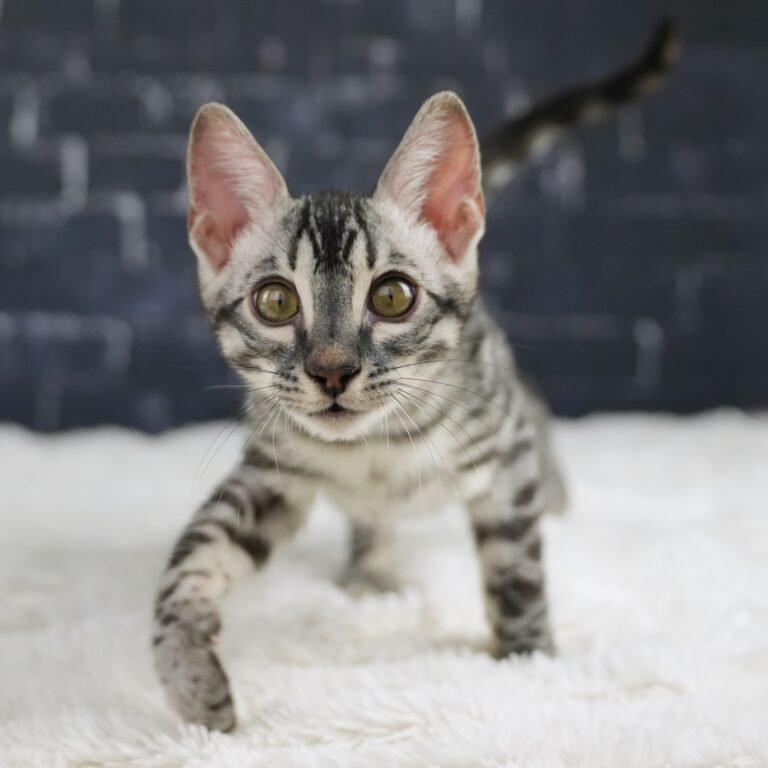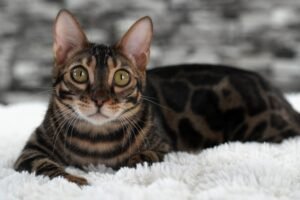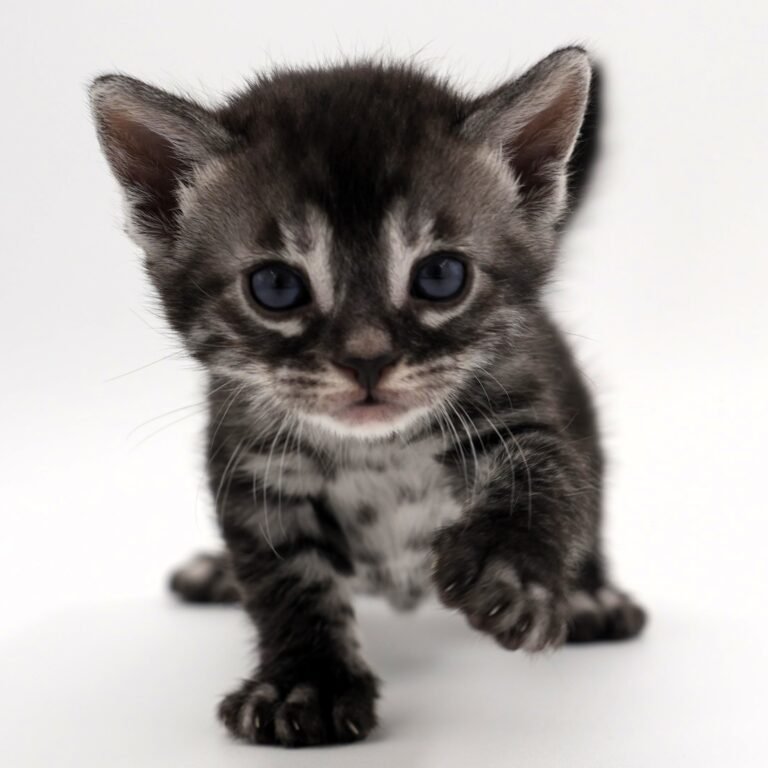The Fascinating World of Black Bengal Cats
Black Bengal cats are a captivating and unique variation within the Bengal breed, known for their striking dark coats and wild-inspired markings. These extraordinary felines come in two distinct types: the Charcoal Bengal and the Melanistic Bengal. lets dive deep into the history, genetics, and characteristics that set these cats apart!
Black Bengal Cat Photo Gallery
Charcoal Bengal Cat Photos
Melanistic Bengal Cat Photos
The Charcoal Bengal Cat
Charcoal Bengal cats are distinguished by their dark appearance, resulting from a unique pattern effect that creates a shadowed look over their coat often reffered to as “Zorro markings“. The most notable features of Charcoal Bengals include:
A dark “mask” covering their face
White or near-white “goggles” around the eyes
A dark “cape” along the spine
The Melanistic Bengal Cat
Melanistic Bengals are characterized by their solid-colored coat, which often obscures the spotting or marbling pattern typically associated with the Bengal breed. However, under certain lighting conditions, a faint “ghost pattern” may be visible.
The Melanistic pattern effect can manifest differently depending on the Bengal’s base coat color:
In Brown Bengals, it results in a “melanistic” or “panther-like” appearance
Red Bengals remain unaffected by the Melanistic pattern
Snow Bengals with the Melanistic pattern affect appear as a “solid” color
Silver Bengals with the Melanistic pattern have a unique “smoke” appearance
The History of Black Bengal Cats
Exploring the fascinating journey of two unique Bengal variations and their path to recognition in the cat world.
The Charcoal Bengal's Rise to Recognition
Early Development
Initially misunderstood and often bred against, the Charcoal Bengal’s unique appearance was overlooked until visionaries like Terra Sinclair of Pocket Leopards recognized their potential. Sinclair’s contribution was pivotal, as she coined the term “Zorro markings” to describe their distinctive features, helping create a clear identity for these special cats.
Scientific Breakthrough
The 2014 study “Who’s behind that mask and cape?” marked a turning point, as researchers identified a specific Agouti allele (ASIP) variant inherited from the Asian Leopard Cat as the source of the charcoal pattern. This discovery validated years of breeding efforts and sparked wider appreciation for the variation.
Recognition & Achievements
2016: CFA begins registering Bengals, including the charcoal variation, allowing them to compete in shows
2019: BOYDSBENGALS PRINCESS CLEOPATRA makes history as the first Charcoal Bengal to earn CFA’s Grand Premier title
2020: BOYDSBENGALS STORM BREAKER becomes CFA’s first Charcoal Bengal Grand Champion
2020: TICA grants Championship status to Charcoal Bengals (May 1), marking a historic milestone
Today, the Charcoal Bengal stands as a celebrated member of the Bengal family, admired for its striking appearance and fascinating history. Their journey exemplifies the innovation and dedication that define the feline world.
The Melanistic Bengal's Legacy
Historical Origins
The Melanistic Bengal’s story begins in the 1960s with Jean Sudgen Mill’s groundbreaking work. An Asian Leopard Cat named Malaysia was bred with suspected Melanistic domestic cats, introducing this distinctive trait to the Bengal breed. This trait was likely reintroduced multiple times throughout the breed’s development.
Recognition Challenges
Initially, Bengal enthusiasts focused primarily on developing the breed’s signature spotted or rosetted coat patterns, viewing these as the hallmark of wild heritage. This led to Melanistic Bengals being seen as an undesirable deviation from the breed standard, a perspective some breeders maintain today.
Current Status & Future
As of 2024, TICA has not yet granted official recognition to Melanistic Bengals for show purposes. While CFA acknowledges their existence in breed standards, no Melanistic Bengals have received Grand titles in competition. However, these cats represent a unique chapter in the Bengal story, challenging traditional expectations and showcasing the breed’s diverse potential.
The Melanistic Bengal’s journey continues, embodying the principle that beauty and worth transcend conformity. Their story remains a testament to the rich diversity within the Bengal breed.
Black Bengal Cat Genetics
Explore Black Bengal cat genetics to discover how different alleles (gene variants) interact to create their distinctive coat patterns. Learn about inheritance patterns using our interactive calculator to explore possible kitten outcomes, and delve into the groundbreaking research that revealed how Asian Leopard Cat genes influence these beautiful patterns.
Understanding Black Bengal Cat Genetics
The "A" locus, also known as the Agouti locus, controls pigment distribution in individual hair shafts, leading to unique coat appearances. The interplay between different alleles at this locus, particularly those inherited from the Asian Leopard Cat, results in the diverse patterns seen in Bengal cats, including charcoal and melanistic variations.
Normal Bengal Pattern (A)
A/Apb
A/a
The dominant "A" allele produces the standard Bengal pattern. Both charcoal and melanistic alleles are recessive to this dominant allele found in most Bengal cats. For special traits like charcoal or melanistic to appear, specific allele combinations must be inherited from both parents.
Charcoal Variations (Apb)
Apb/a
Twilight Charcoal (Apb/Apb)
Two copies of the Asian Leopard Cat (ALC) agouti allele "Apb" typically create a lighter charcoal pattern known as "Twilight Charcoal."
Midnight Charcoal (Apb/a)
When the Asian Leopard Cat allele "Apb" combines with one copy of the domestic cat non-agouti allele "a", it results in a darker "Midnight Charcoal" variant.
Melanistic Pattern (a/a)
Two copies of the non-agouti allele "a" result in a solid-colored coat by preventing the normal banding of pigment on individual hairs that creates a tabby pattern. The underlying Bengal pattern may still be visible as "ghost markings" under certain lighting conditions.
Black Bengal Cat Genetic Calculator
Parent 1
First Allele:
Second Allele:
Parent 2
First Allele:
Second Allele:
The ASIP Gene Study: Who's behind that mask and cape?
Quick Study Overview
Research Title: "Who's behind that mask and cape? The Asian leopard cat's Agouti (ASIP) allele likely affects coat colour phenotype in the Bengal cat breed"
Research Team: L C Gershony, M C T Penedo, B W Davis, W J Murphy, C R Helps, L A Lyons
This groundbreaking research reveals how different alleles from both domestic and wild cats combine to create unique Bengal cat coat patterns. The study focused on the ASIP gene and its various alleles, which play a crucial role in determining coat color and pattern.
Understanding the Basics
ASIP Gene: A gene that helps control the production and distribution of pigments in animal fur
Allele: Different versions of the same gene
Heterozygous: Having two different versions (alleles) of a gene
Bengal cats are unique because they inherit different alleles from both domestic cats and Asian leopard cats. This study focused on understanding how different versions of the ASIP gene influence coat color when inherited from both parent species.
ASIP Alleles in the Study
APb
The Asian leopard cat's allele of the ASIP gene
A
The wild-type allele found in domestic cats
a
The non-agouti allele found in domestic cats that can cause solid black coloring
A2
A newly discovered allele found in some Bengal cats
The Research Process
- 148 Bengal cats
- 11 Asian leopard cats
- 6 domestic cats
- Additional wild cats (servals and jungle cats) for comparison
Detailed examination of three crucial sections (exons) of the ASIP gene that contain instructions for making the ASIP protein.
Comparison of ASIP alleles between different cats to identify specific genetic variations.
Major Discoveries
Key Finding 1: Genetic Differences
27 genetic differences identified between domestic cats and Asian leopard cats in the ASIP gene:
- 8 differences in protein-coding regions
- 19 differences in non-coding regions
Key Finding 2: Charcoal Pattern Genetics
Specific combination of alleles found in most charcoal Bengals:
- One copy of the APb allele (from the Asian leopard cat)
- One copy of the 'a' allele (the domestic cat's non-agouti variant)
Key Finding 3: New Genetic Variant
Discovery of a previously unknown ASIP allele (named "A2") in Bengal cats, not found in either domestic or wild cats.
Research Implications and Achievements
- Genetic Testing Development: The discovery of multiple ASIP alleles necessitates new testing protocols that can identify both domestic and wild cat variants
- Breeding Program Enhancement: Understanding these specific allele combinations enables more precise breeding strategies for desired coat patterns
- Future Research Directions: The discovery of the A2 allele suggests potential for more unknown genetic variations affecting coat color
- Conservation Genetics: Provides insights into how wild cat genes persist and express in hybrid populations
- Validation of Wild Gene Expression: First scientific confirmation that the APb allele from leopard cats continues to affect Bengal cats' appearance and demonstrates how different alleles can interact to create unique characteristics

















